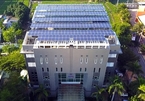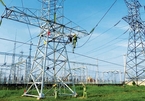In Vietnam, low-cost power sources including hydropower and coal-fire thermopower are either becoming exhausted or not being developed further for many reasons.

Meanwhile, alternative power sources such as solar and wind power, gas- and oil-run power have high production costs, several times higher than the current average electricity price of VND1,846 per kwh.
The Electricity of Vietnam (EVN) estimates that when using 8.6 billion kwh of electricity from oil-run plants, with the lowest unit production cost of VND3,500 per kwh, the additional production cost would be VND14 trillion.
However, 8.6 billion kwh is the lowest scenario. Experts estimate that the figure could be 12-16 billion kwh, which means that the additional production cost would be even higher.
| As for solar power, EVN now has to subsidize VND1.5 trillion a year for solar power plants. Meanwhile, the coal and gas prices in the world market may increase at any time. |
As for solar power, EVN now has to subsidize VND1.5 trillion a year for solar power plants. Meanwhile, the coal and gas prices in the world market may increase at any time.
All these factors put pressure on the electricity pricing options for upcoming years.
However, the high price proves is not the worst risk. According to EVN, the electricity output from oil-run sources in October 2019 was 400 million kwh, while the figure may reach 1.45 billion kwh by the end of the year.
Experts said that 400 kwh of electricity a month from oil-run sources is a reasonable level to ensure smooth operation of the system. If the figure is raised to 500-700 kwh a month, there will be challenges in oil supply and machines. The high demand for electricity generation from oil will affect the system.
Power plants still feel headaches about the oil supply in case the demand for oil surges suddenly. No power plant wants to spend big money to store oil because the oil price in the world market is unpredictable, which may bring risks.
Meanwhile, power plants programmed to run with oil are all located in the areas where the transport infrastructure conditions are not good. So, they would have transport problems if they don’t plan to carry oil soon.
According to Tran Viet Ngai, chair of the Vietnam Energy Association, it is necessary to step up the implementation of power generation and transmission projects to ease the power shortage.
“We have to not only call on people to use power-saving equipment, but also ask to renovate technologies in steel, cement and chemicals plants,” he said.
In the long run, in order to ensure stable electricity supply and sustainable power development, it is necessary to raise the electricity retail price.
Mai Lan

Renewable energy projects in Ninh Thuan face overloaded electricity grid
The central province of Ninh Thuan has seen a boom in renewable energy projects, especially solar power, but power transmission lines in the province have failed to handle the capacity, experts have said.

Vietnam supports private investment in electricity transmission lines
Allowing private investors to develop electricity transmission lines is expected to be the best solution to settle the electricity shortage.
 The solution of using electricity from oil-run power sources will increase the production cost by VND14 trillion, which will put pressure on electricity prices.
The solution of using electricity from oil-run power sources will increase the production cost by VND14 trillion, which will put pressure on electricity prices.